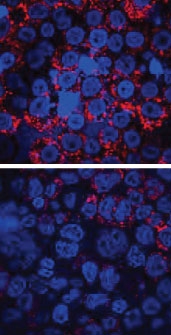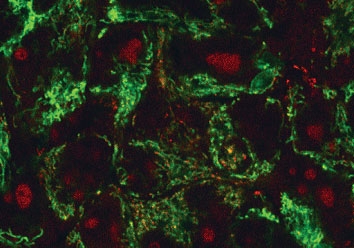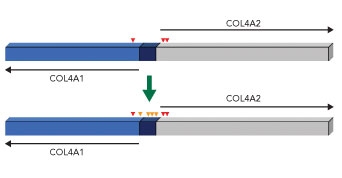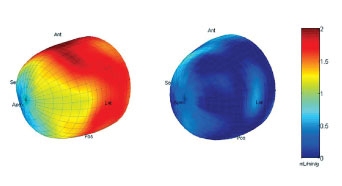Every research institute is driven by its army of graduate students and post-doctoral fellows. They bring their enthusiasm and curiosity to the lab each day and create new collaborative relationships between research groups, both down the hall and around the globe. The Beat spoke with four graduate students at the University of Ottawa Heart Institute about their reasons for coming to train here, their ongoing research and their plans for the future.
“The Heart Institute, in my opinion, has always put a lot of value on training future scientists,” said Patrick Burgon, PhD, Principal Investigator in the Cardiovascular Endocrinology Program. “And in this day and age, in the life sciences especially, you’re really only as good as the graduate students and post-doctoral fellows you can attract to your lab.
“You may have the best ideas in the world, but you need outstanding people to help you execute them,” he continued. “And the trade-off for that help is they get an opportunity to train in a pretty amazing place for cardiovascular sciences.”
Different Paths to Cardiovascular Research
The graduate students at the Heart Institute come from diverse backgrounds and experiences throughout Canada and internationally. Some get an introduction early in their careers. Adam Turner, currently working on his doctoral degree in the Atherogenomics Laboratory of Ruth McPherson, MD, PhD, spent several summers as an undergraduate in Burgon’s laboratory and performed his fourth-year thesis research project there.
Turner returned for his graduate studies in cardiovascular genetics after several years in a government research position. “When I worked in a government genetics lab, I became quite interested in genetics research. From my previous time at the Heart Institute, I heard about some interesting genetics projects going on in Dr. McPherson’s lab and contacted her for a graduate student position,” he recalled.

Josh Raizman, who is working on his PhD in the Vascular Biology Laboratory, had heard of the Heart Institute’s reputation for translational research. “That’s something I really wanted to do coming out of my master’s work, where I focused mostly on cell work and in vitro models,” he said.
Naif Almontashiri, a PhD student in the Ruddy Canadian Cardiovascular Genetics Centre supervised by Alexandre Stewart, came from Saudi Arabia after his undergraduate work at the Faculty of Medical Sciences at Umm Al-Qura University in Mecca. “The Heart Institute is known worldwide for its expertise in the field of cardiovascular genetics and as the centre that discovered the first genetic risk locus for coronary artery disease. That’s why I came specifically to this institute,” he explained.
Stephanie Thorn, who plans to complete her doctorate work in 2012 under the co-supervision of Jean DaSilva, PhD, and Michael Gollob, MD, took a less traditional path to academic research. She came to the Heart Institute as a research technician after finishing a master’s degree in nutritional neuroscience at the University of Guelph and spent several years as an employee in the DaSilva lab.
“Part of my job at the time was to take pilot projects, run them and get some data so that we could apply for grants,” she recounted. “When a project was funded, the lab would bring in students. I would get them up and running and hand off the project. When I started working on the one that’s now my PhD project, I fell in love with it, and I didn’t want to hand it off. I wanted to keep it.” She transferred into the PhD program in her third year at the Heart Institute.
From Genes to Disease, Mice to Patients
Thorn’s graduate research recently won her the student runner-up prize for basic science at the Canadian Cardiovascular Congress. As a student working in the Molecular Function and Imaging Program, funded by a Heart and Stroke Foundation program grant, she is co-supervised by a radiochemist (DaSilva) and a clinician-scientist (Dr. Gollob), who specializes in genetic arrhythmias.
Her work uses nuclear imaging, DaSilva’s specialty, to understand an inherited arrhythmia disease that affects several families in the Ottawa region and leads to cardiomyopathy and heart failure by the age of 40 or 50.
The team has developed a mouse model that has the same mutation—in a gene called AMPK—that drives the disease in humans. They are trying to understand how that mutation causes the heart to store glycogen, how that abnormal glycogen storage relates to the arrhythmias and how to potentially treat the disorder.

“That’s where the imaging comes in handy, because we see a lot of the same radiotracer patterns in mice and in our patients. Now, we’re looking at the biochemistry behind those patterns in mice so we can try to understand what’s occurring in the human heart without using any invasive procedures,” Thorn explained.
Since she arrived at the Heart Institute, the core imaging facility has acquired microPET, microSPECT, and other advanced animal imaging technologies that closely mirror the diagnostic imaging capabilities of the clinical facilities. “It’s become really interesting to work in imaging because of the translational potential we have now,” Thorn added.
Almontashiri and Turner are both working to understand the nuts-and-bolts mechanisms linking genetic variation to cardiovascular disease risk. The McPherson lab has identified mutations in a collagen gene that are associated with coronary artery disease. “My project is to decipher how these mutations—through what cellular pathways—lead to heart disease,” explained Turner, who presented a poster at the American Society for Human Genetics meeting in Montreal this year.
“The Heart Institute is known worldwide for its expertise in the field of cardiovascular genetics.…That’s why I came specifically to this institute.” – Naif Almontashiri, PhD student, Ruddy Canadian Cardiovascular Genetics Centre
Thanks to the close proximity between the Heart Institute labs and the clinic, Turner’s group has collected DNA samples from thousands of patients with coronary artery disease as well as from thousands of healthy patients. Turner is currently sequencing the DNA of both groups to look for differences in the collagen gene.
In Almontashiri’s master’s work, he explored how a mutation in a mitochondrial gene called SPG7 increases the risk for coronary artery disease by speeding up the cell cycle and causing oxidative damage. For that research, he collaborated with the laboratory of Heidi McBride in the Lipoprotein and Atherosclerosis Program and also internationally, with researchers from the University of Cologne in Germany.

For his doctoral research, he has focused on a biomarker called interferon-alpha 21, which is strongly predictive of cardiovascular disease risk in people who have two copies of the 9p21 genetic risk variant, first discovered at the Heart Institute. For these patients, the biomarker is so predictive of disease, he explained, “we hope it will replace an angiogram for them soon, for diagnosis.”
The biomarker may even have an advantage over the traditional angiogram in that it is more proactive. “An angiogram,” Almontashiri continued, “is done when you have the symptoms of a myocardial infarction—it’s already happened. But with this biomarker, maybe you can actually prevent CAD in these patients by catching them early and helping them take care of their hearts.” This work earned him a prestigious trainee award this year from the American Society of Human Genetics, beating 5,000 other student submissions.
In Raizman’s master’s work in physiology at the University of Manitoba he studied wound healing in the heart after myocardial infarction. At the Heart Institute, he is studying a cellular pathway leading to atherosclerosis. “That’s the cause of myocardial infarction. So, it’s been a full circle of what happens in the heart,” he said.

His doctoral work is focused on a protein called HSP27, that protects other proteins in the body from damage and appears to play a role in preventing the development of foam cells, which directly lead to atherosclerotic plaque formation. After developing a better understanding of HSP27 in rodents, he has begun developing small molecules that could potentially act as improved versions of the protein. The goal is to develop new drug treatments for cholesterol buildup in the blood vessels.
“At the Heart Institute, the way the physical space is set up, you step out of the lab and you’re in the clinical realm. Walking from the lab, you really cross over physically from bench to bedside, so you’re always thinking about the patients who might benefit from the research down the road,” he said. “That really motivates us and drives our research.”
Planning for the Future
The four students have plans for the future as diverse as their backgrounds. Thorn hopes to continue in Canadian academia with a post-doctoral position after she defends her dissertation next year.
After Almontashiri finishes his degree and post-doctoral work in Canada, he has a faculty position waiting for him back home. His university, in Saudi Arabia, is establishing a new genomic excellence centre. “I’m hoping to bring collaborations with many Canadian professors and scientists with me back home, which can become international collaborations,” he explained.
Both Raizman and Turner are currently considering research paths outside academia. Turner is potentially interested in a career as a molecular geneticist, performing DNA-based diagnostics in a hospital environment. Raizman has his eye on training as a clinical biochemist. This would allow him to both help diagnose patients and have access to a large pool of potential samples from diverse populations to continue his research.
“Other students and post-docs are always willing to share their expertise, no matter what time of day.” – Josh Raizman, PhD student, Vascular Biology Laboratory
Until they leave, all four plan to continue developing the close relationships they have in their labs and with other students throughout the Heart Institute. “I think the Heart Institute really promotes questions being asked and finding the right people to answer those questions. Other students and post-docs are always willing to share their expertise, no matter what time of day. It’s very collegial, and that’s important because I think the best science happens in environments where you’re not afraid to seek help and seek answers,” said Raizman.
“From my past experiences as a graduate student and as a post-doc, I think one of the most important things that a research institution can do is facilitate these interactions among the trainees. Quite often that will lift a place up—they get excited, and that energy trickles up the ranks,” concluded Burgon.

